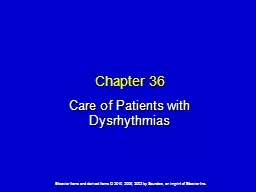

Review of Cardiac Electrophysiology Automaticity Excitability Conductivity Contractility Cardiac Conduction System Cardiac Conduction System Contd Sinoatrial node Electrical impulses at 60 to 100 beatsmin ID: 662776
Download Presentation The PPT/PDF document "Chapter 36 Care of Patients with Dysrhyt..." is the property of its rightful owner. Permission is granted to download and print the materials on this web site for personal, non-commercial use only, and to display it on your personal computer provided you do not modify the materials and that you retain all copyright notices contained in the materials. By downloading content from our website, you accept the terms of this agreement.
Slide1
Chapter 36
Care of Patients with DysrhythmiasSlide2
Review of Cardiac Electrophysiology
Automaticity
Excitability
Conductivity
ContractilitySlide3
Cardiac Conduction SystemSlide4
Cardiac Conduction System
(Cont’d)
Sinoatrial node:
Electrical impulses at 60 to 100 beats/min
Reflected in a P wave on the ECG
Atrioventricular junctional area
reflected in the PR segment on the ECG
contraction known as “atrial kick”
Bundle of His:
Right bundle branch system
Left bundle branch systemSlide5
Electrocardiography
Copyright © 2010, 2006, 2002 by Saunders, an imprint of Elsevier Inc.Slide6
Electrocardiography (Cont’d)
Electrocardiogram (ECG)
Lead systems
Limb leads
Chest leads
Continuous electrocardiographic monitoring
TelemetrySlide7
Electrocardiographic WaveformsSlide8
Electrocardiographic Waveforms (Cont’d)Slide9
Electrocardiographic Complexes, Segments, and Intervals
P wave
PR segment
PR interval
QRS complex
QRS duration
ST segment
T wave
U wave
QT intervalSlide10
Normal ECGSlide11
Determining Heart RateSlide12
Electrocardiographic Rhythm Analysis
Determine the heart rate.
Determine the heart rhythm.
Analyze the P waves.
Measure the PR interval.
Measure the QRS duration.
Interpret the rhythm.Slide13
Normal Rhythms—
Normal Sinus RhythmSlide14
Sinus Rhythms Slide15
Sinus Bradycardia
Copyright © 2010, 2006, 2002 by Saunders, an imprint of Elsevier Inc.Slide16
Sinus Tachycardia
Copyright © 2010, 2006, 2002 by Saunders, an imprint of Elsevier Inc.Slide17
Sinus Arrhythmia
Variant of NSR
Results from changes in intrathoracic pressure during breathingSlide18
Dysrhythmias
Tachydysrhythmias
Bradydysrhythmias
Premature complexes
Repetitive rhythm complexes:
Bigeminy
Trigeminy
Quadrigeminy
Escape complexes and rhythmsSlide19
Sinus Dysrhythmias
Sinus tachycardia
Patient-centered collaborative careSlide20
Sinus BradycardiaSlide21
Atrial DysrhythmiasSlide22
Premature Atrial Complexes
Ectopic focus of atrial tissue fires an impulse before the next sinus impulse is due.Slide23
Supraventricular Tachycardia
Rapid stimulation of atrial tissue occurs at a rate of 100 to 280 beat/min with a mean of 170 beats/min in adults.
Paroxysmal supraventricular tachycardia rhythm is intermittent and terminated suddenly with or without intervention.Slide24
Supraventricular Tachycardia (Cont’d)
Copyright © 2010, 2006, 2002 by Saunders, an imprint of Elsevier Inc.Slide25
Atrial FibrillationSlide26
Atrial Fibrillation (Cont’d)
Patient-centered collaborative care:
Risk for emboli
Antiarrhythmic drugs
Cardioversion
Radiofrequency catheter ablation
Pacing
Maze procedureSlide27
Atrial Fibrillation Compared with Normal Sinus Rhythm Slide28
Atrial Flutter
Rapid atrial depolarization occurring at a rate of 250 to 350 times per minuteSlide29
Atrial Flutter at 100 beats/min
Copyright © 2010, 2006, 2002 by Saunders, an imprint of Elsevier Inc.Slide30
Junctional Dysrhythmias
Nodal cells in the AV junctional area that generate electrical impulses and are therefore latent pacemaker cells
40 to 60 beats/min
These rhythms are most commonly temporary and the patients usually remain stableSlide31
Ventricular DysrhythmiasSlide32
Idioventricular Rhythm
Also called
ventricular escape rhythm
—
ventricular nodal cells pace the ventricles. P waves are independent of the QRS complex (AV dissociation).
Idioventricular rhythm is seen as a rhythm in the dying heart.
Emergency care. Slide33
Premature Ventricular Complexes
A result of increased irritability of ventricular cells
—
early ventricular complexes followed by a pauseSlide34
Ventricular Tachycardia
Also called
V tach
—
repetitive firing of an irritable ventricular ectopic focus, usually at a rate of 140 to 180 beats/minSlide35
Ventricular Fibrillation
Also called
V fib
—
a result of electrical chaos in the ventriclesSlide36
Ventricular Fibrillation (Cont’d)
Copyright © 2010, 2006, 2002 by Saunders, an imprint of Elsevier Inc.Slide37
Ventricular Asystole
Also called
ventricular standstill
—
complete absence of any ventricular rhythmSlide38
Asystole
Emergency careSlide39
Atrioventricular Blocks
Atrioventricular blocks are differentiated by their PR interval:
First-degree atrioventricular block
Second-degree atrioventricular block
Third-degree atrioventricular blockSlide40
Bundle Branch Blocks
Conduction delay or block within one of the two main Bundle of His branchesSlide41
Dysrhythmias: Nonsurgical Management
Antidysrhythmic agents
Other drugs
Drugs used during cardiac arrest
Vagal maneuvers
—
carotid sinus massage, vagal reflexSlide42
Pacemakers
Temporary pacing
—
invasive and noninvasive
Permanent pacemakersSlide43
Management of Cardiac Arrest
Cardiopulmonary resuscitation
Advanced cardiac life supportSlide44
Cardioversion
Synchronized countershock that may be performed in emergencies for unstable ventricular or supraventricular tachydysrhythmias or electively for stable tachydysrhythmias that are resistant to medical therapiesSlide45
Defibrillation
Asynchronous countershock depolarizes a critical mass of myocardium simultaneously to stop the re-entry circuit and allow the sinus node to regain control of the heartSlide46
Other Therapies
Automatic external defibrillation
Radiofrequency catheter ablation
Surgical procedures:
Permanent pacemaker
Coronary artery bypass grafting
Aneurysmectomy
Insertion of implantable cardioverter/defibrillator
Open-chest cardiac massageSlide47
Community-Based Care
Home care management
Health teaching
Health care resources